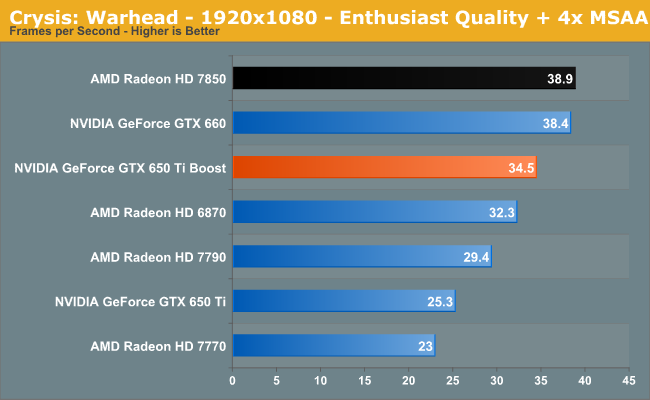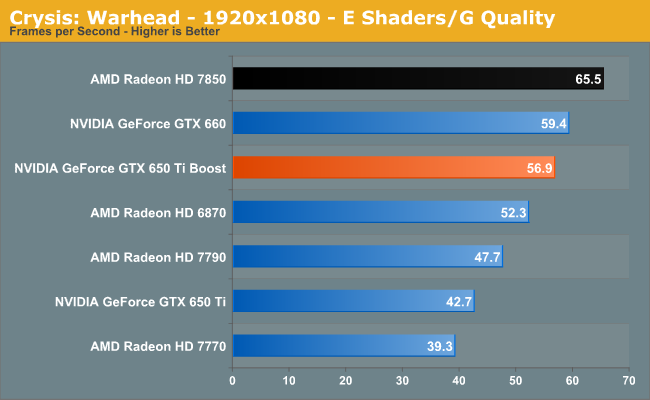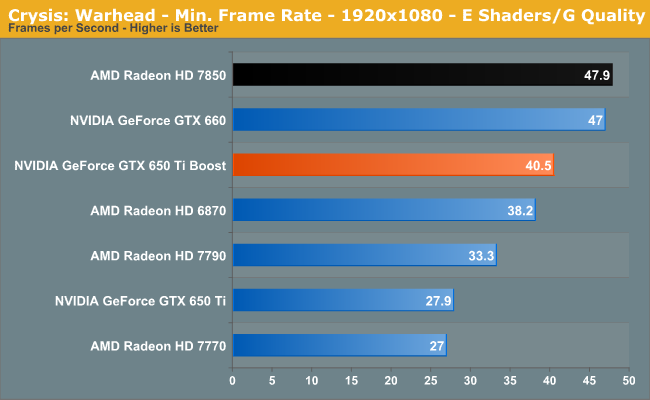NVIDIA GeForce GTX 650 Ti Boost Review: Bringing Balance To The Force
by Ryan Smith on March 26, 2013 8:00 AM ESTCrysis: Warhead
Up next is our legacy title for 2013, Crysis: Warhead. The stand-alone expansion to 2007’s Crysis, at over 4 years old Crysis: Warhead can still beat most systems down. Crysis was intended to be future-looking as far as performance and visual quality goes, and it has clearly achieved that. We’ve only finally reached the point where single-GPU cards have come out that can hit 60fps at 1920 with 4xAA.


Crysis has shown to favor raw ROP performance and memory bandwidth above shader performance, so it’s been a rough game for NVIDIA’s Kepler cards, which typically have less memory bandwidth than their AMD competition. In this case at Gamer quality the GTX 650 Ti Boost still can’t crack 60fps, and it’s trailing the 7850 by 12%. On the other hand it has 50% more memory bandwidth than the 7790, so the 1GB variant may be interesting to see here if it can achieve similar results as the 2GB variant.
It’s interesting to note though that because this game depends so much on ROP performance and memory bandwidth that this is as close as we’ll see the GTX 650 Ti Boost get to the GTX 660. There’s less than 5% separating them at Gamer quality; these cards have plenty of shading/texturing performance, but not enough ROP performance to satisfy Crysis.


Jumping to our minimum framerates, we do see things open up a bit as shader bottlenecking does occur in a few places. The result is that the GTX 650 Ti Boost falls well behind the 7850 in minimums, and the full GK106 GTX 660 pulls ahead. Still, the difference between the GTX 650 Ti and its boost variant is nothing short of staggering; the boost card leads by 45% here, relying heavily on those ROP and memory bandwidth advantages.










78 Comments
View All Comments
Bob Todd - Tuesday, March 26, 2013 - link
More data points are usually a good thing, but can I ask what you'd use that for? Since you can't install one in the other, beyond the novelty of knowing how close a midrange desktop card is to a halo mobile part I'm curious to know what you want out of it. It seems like on the mobile side most parts are 2-3 rungs below the desktop part of the same name throughout the lineup.Hrel - Tuesday, March 26, 2013 - link
I base card recs on how long they intend to keep it. On a budget? Ok, get something that will run 1080p for a year or two. 1GB 650 ti or 7790. Idk, I'd have to look at those two to really know between that. But then after that point spend more a 2GB card with a 256bit memory interface. (GTX660 192bit, WTF Nividia?) BUT, if you have some more money and want to keep the card 4 years or more, get the 7850. The 7850 will be faster now, last longer. But whatever card you'd replace the 650 ti with in a year or two for the same price will be even faster than that.I really don't like where the GPU market is right now. It feels stagnant. Nothing is really a good deal. Like you guys said, there is no sweet spot. The 8800GT was the card to get after the price dropped below 150. Same for the GTX460. Now to get that level of performance they expect you to shell out 220 bucks. Fuck that. I say, for now, either keep your current card or buy the cheapest one you can possibly stomach. This market needs to straighten itself out again.
I'm keeping my GTX460 until I literally can't run games anymore. Don't really care if I have to turn off AA in new titles. Neither company has given me a reason to upgrade. Sub 200 used to be competitive.
just4U - Wednesday, March 27, 2013 - link
Well.. generally speaking the 660 and the 7870 are currently enjoying the sweet spot. Neither card breaks the bank and the trade off in the +$300 range isn't so great to be a game breaker.The 460 was a $240 card when it launched and both of the ones I mentioned can be had for $220 if you look around.. (not including mail in rebates etc or game bundles). On average their 70% faster than 460 but over the past few years there's been a focus on loading temperatures, power consumption, and other features.. which is something that got kick-started around the time of the 460. Right now it's not giant leaps forward but rather, several steps to the side with a few steps forward in performance.
just4U - Wednesday, March 27, 2013 - link
Also.. if the 460 was your last purchase over the 8800 than your buying every third generation.. For you that wont come up until the next line-up/fall refresh.Calinou_ - Wednesday, March 27, 2013 - link
Want a large memory bus for cheap? Get an used GTX 570, then you have a 320 bit memory bus for the price of a 650 Ti. Then deal with the 250W in full load. :DShadowmaster625 - Tuesday, March 26, 2013 - link
The 7850 is a 10% larger die. So with all things being equal you can expect roughly 10% more performance. Both chips contain significant fused off sections but the amount that is fused off is roughly the same in percentage terms.The 7850 at stock is leaving an awful lot of performance on the table. You can tell this just by looking at the power consumption. Overclock the 7850 until its power consumption matches this new nvidia card, and how much performance differential are we now talking about? Well over 10% I'm sure...
The 650 Ti Boost is clearly more aggressively timed and configured, to squeeze out more dollars out of the enthusiast's pocket and into Nvidia's. The fact that the review doesnt really mention any of this is kind of surprising. I would say the 7850 is a better deal, based on the assumption that it has more overclocking overhead. Given the same 28nm process vs the difference in die sizes, that is surely a safe assumption.
mczak - Wednesday, March 27, 2013 - link
7850 doesn't have larger die. Pitcairn is quoted as 212mm^2 whereas gk106 is actually 221mm^2 (though the difference might be just be measuring differently, i.e. including the empty space at the edges or not if those are official, not measured, figures). Pitcairn does have 10% more transistors though (I guess for whatever reason amd could pack them more densely overall).But yes pitcairn is faster than gk106 overall. The reason the gtx660 loses to hd7870 but the gtx650ti boost is very close to hd7850 is of course that hd7850 is a hd7870 with 20% less shader units and 14% less clocks, whereas the 650ti boost is a 660 with 20% less shader units but same clocks. And yes this shows in overclocking potential and perf/w.
royalcrown - Tuesday, March 26, 2013 - link
Too many cards, just buy a 660 !Spunjji - Wednesday, March 27, 2013 - link
Too many cards, just buy a 7870!FTFY ;)
silverblue - Tuesday, March 26, 2013 - link
Nice card. Okay, the power draw is a bit of a downside, meaning we've got a 680-7970-esque comparison again between the 7850 and 650 Ti Boost where the former performs a little better in general whilst using less power, however considering the gap to the 660 isn't that big, is it worth the extra money?I can definitely see people buying these; that extra 1GB will certainly help in time.